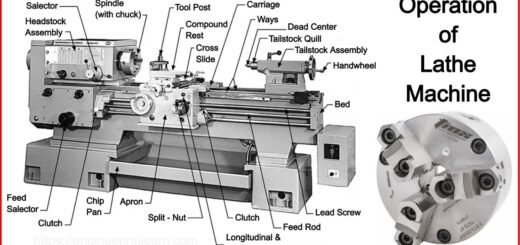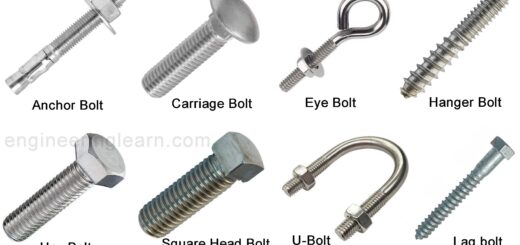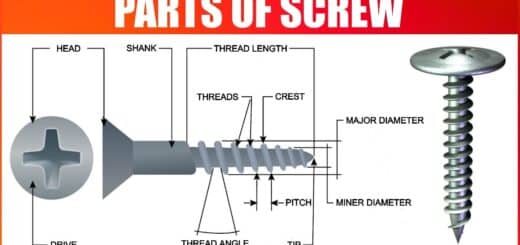Compression Spring: Types, Working, Uses, Parameters, Material, Design, Applications, Advantages & Disadvantages

What is Compression Spring?
Compression Spring: Types, Working, Uses, Parameters, Material, Design, Applications, Advantages & Disadvantages :- A compression spring can be defined as a open coil helical spring which can provide resistance against the compressive force which is applied axially. Compression springs are generally coiled at constant diameter as well as they are coiled in various forms according to the requirement like convex, concave and conical etc. They can be used for resisting compressive force or for storing energy.
General Parameters Used for Compression Spring
1. Unit of Measures
Springs are measured in pound, inches and metric units.
2. Rate
It is defined as the rate of change of load per unit deflection in newton per mm.
3. Stress
Whenever a compression spring is loaded, stress is being generated and the value of stress is high at the surface of wire. The value of stress governs the life of the spring. If the rage of operating stress is wider than the stress generated in the body of spring is lesser. Higher stress is used when the rage of operating stress is narrow.
4. Ends
There are generally four main types of end conditions. The end can be unground as well as ground and the end coils can be closed or open coils.
5. Outside Diameter
It is the diameter formed by the outside surface of the spring coil.
6. Hole Diameter
It is the diameter in which the spring is being inserted. It can also know as the mating part diameter of spring. And hole diameter are generally designed greater than the outside diameter of the spring for avail space in case of spring expansion when the load is applied.
7. Rod Diameter
It is the diameter of rod which is inserted through the spring. It is used as guide shaft for minimizing the buckling of spring under compressive load. The rod diameter is always designed lesser than the inside diameter of the spring but it should not be too small else it will looses their ability of minimizing the buckling of spring.
8. Free Length
It is defined as the length of spring measured when the spring is not loaded.
9. Wire Diameter
It is the size of the raw material used for making spring. Round wires of a specified diameter is used for making conventional springs.
10. Solid Height
It is defined as the dimension of spring when it is in maximum loaded condition.
11. Load at Solid Height
It is the value of load which is needed for completely deflecting the compression spring to the point where soils of the spring are completely pressed together.
Working of Compression Spring
Compression springs have always axially loaded compressive force and whenever heavy load is applied to the compression spring they store the load till they get released. These type of springs are generally very common for various of application because of their efficiency.
Compression springs can be of various shapes and sizes which can be placed on a rod or fit into a hole for a particular application. Its adaptability avail them for customized work according to the requirement. Customized springs can possess identical characteristics like non linear load deflection, extreme space efficiency, improved energy storage capacity etc.
Design of Compression Spring
Design of compression spring is complex but it allows the uses for various of application and different settings. Some variables are considered for the designing of spring are:
- Number of coil
- End type
- Expected life
- Wire shape
- Stress tolerance
- Operating condition
- Wire material and diameter
- Industrial or commercial requirements
- Coil length, shape, direction and tightness
Applications of Compression Spring
Various applications of the compression spring are:
- For controlling motion and to apply forces.
- In case of spring balance they are used for measuring forces.
- In case of watches and toys they are used for storing energy.
- In machine and vehicles they reduce the effect of vibration as well as shocks
Types of Compression Springs
1. Magazine Springs
These types of spring are used in firearms. Magazine springs are of rectangular or oval in shape coil therefore they can be used in various other devices also.
2. Conical Springs
Conical springs are used for reducing the solid height of the compression springs. They can do this due to the telescopic effect which is offered by their shape. Conical compression springs are non linear and they does not exert constant force at the time of compression.
3. Barrel Springs
For offering stability to the spring, barrel springs are used. They are also used for reducing the solid height. Barrel springs are also non linear just like conical springs.
4. Torsional Springs
Torsional springs are used when we are using torsion spring for the completion of task which is related to the compression or for providing suspension against objects. They are also useful when there is radial force.
On the basis of shape, the major Types of Compression Springs are:
1. Conical Shaped Compression Spring
In this type of spring, the radius of spring decreases towards the end of the springs and are generally used for battery springs.
2. Hourglass shaped compression spring
This type of springs are tapered towards the center but the diameter of the outer coils are larger.
3. Barrel shaped compression springs
This type of springs is designed in such a way that they reduces their diameter at the ends but are wider at the center.
4. Reduced end compression springs
These types of springs are straight across the center but their end coils are only tapered.
Material Used for Compression Spring
- Generally steel alloys are used for spring materials.
- Popular alloys are oil tempered low carbon, high carbon, stainless steel, chrome silicon, chrome vanadium.
- There are some metals like beryllium copper alloy, titanium and phosphor bronze which are used sometimes for spring.
- For coiled springs used for high temperature environment, ceramic materials are used.
Uses of Compression Springs
- Toys
- electronics
- Mattresses
- Pens and notebooks
- Medical devices
- Precision tools and instruments
- Mining and drilling equipment
- Industrial equipment
- Vehicles
Advantages of Compression Spring
- They are useful in resisting the movement of another component.
- When the load is removed then they helps in returning component to its normal position.
- It provides consistent pressure.
- They are light in weight and flexible.
- If tapered spring is used then they provide higher stability.
Disadvantages of Compression Spring
- Conical springs are costly.
- If a spring is left compressed for extended period then it leads to weakening of spring.
- As the time passes spring looses its shape as well as stability.
- Buckling is a problem when the axial load is increased.
- Repairing is difficult if the spring is broken.













